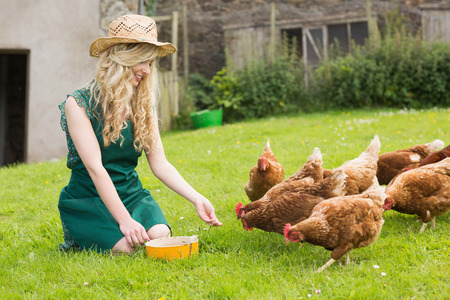
Training your chickens to come when you call them can be handy in a number of situations. You might use the training to gather your flock into the coop when you are ready to close it up for the night. You could call free range chickens together to protect them from a roaming dog or other encroaching predator. You will more easily be able to gather up your flock in event of a natural disaster requiring rapid evacuation. If for no other reason, training your chickens to come when you call them gives you an opportunity to make a quick head count and briefly review the condition of each individual.
To train your chickens to come when you call, select words or some other sound you wouldn’t use for any other purpose.
The classic call is a high pitched “chick, chick, chick.” But you could also choose a specific whistling sound. If you have an actual whistle, other people could use the device to gather your chickens, if necessary, when you aren’t around. Just make sure you always use the same calling sound, and don’t make that sound at any time other than when you deliberately want to call your chickens.
Since eating is one of a chicken’s primary activities, offer your chickens a treat when they respond, providing them with an incentive to come when you call.
A small amount of scratch grain works well during the training phase. Other welcome treats include mealworms or sunflower seeds. If you put the treat in a container that you shake while you call your chickens, the sound of the treat rattling in the container will provide additional inducement to come.
Once the chickens learn to come when you call, you can substitute other healthful but less resounding treats such as chunks of apple, pumpkin, or watermelon. Carrying these new treats in the same container provides a visual clue that a treat is on the way. Your chickens will learn to associate the combination of your call and the appearance of the container with a forthcoming treat.
When chickens begin to arrive, distribute the treat. Some chicken keepers toss the treat on the ground. Others use a paper plate, flat pan, or dog bowl. If your goal is to get the chickens to gather inside their coop, scatter the treat inside.
Initially the boldest flock members will be first to respond. But it won’t be long before the more timid chickens catch on and come running. Repeat the training session at least twice a day, and within about a week the whole flock should be responding quickly and consistently.
At this point you may start training your chickens to respond to your call without expecting a treat.
Discontinue using the usual container as a visual aid. Hide the treat in your pocket, or in a plastic bag inside your jacket, and distribute it only after the entire flock has gathered in response to your call. If you ever need to collect or confine your chickens in a hurry, and you don’t have time to fetch a treat, you’ll be happy they have learned to come merely at your call.
And that’s today’s news from the Cackle Coop.
Gail Damerow, author, Storey’s Guide to Raising Chickens

